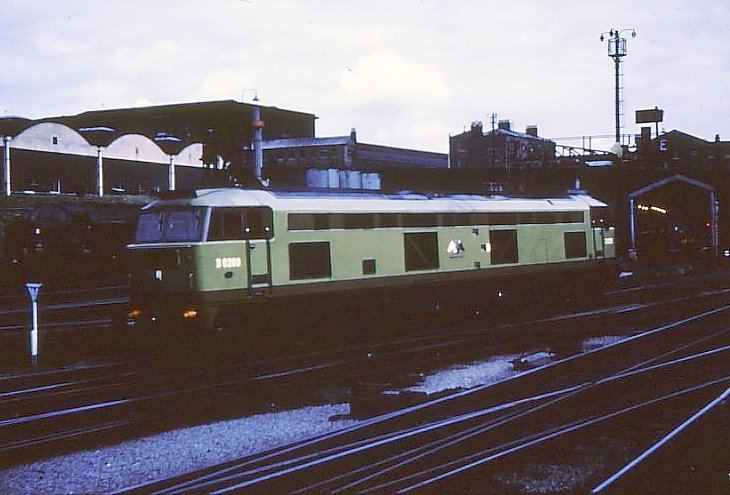Power type Diesel-electric Serial number 280 Configuration Co-Co | Builder Brush Traction Build date 1961 AAR wheel arr. C-C | |
 | ||
British Rail assigned Class 53 to the single Brush Traction-built prototype locomotive Falcon. While not in any sense a failure, the design was the victim of advances in locomotive technology (specifically, the power obtainable from single low-speed diesel engines) and was never duplicated.
History
The Falcon project began in 1959 to design a new, lightweight diesel-electric Type 4 locomotive to meet a British Railways' requirement for second generation diesel locomotives. No single lightweight diesel engine was powerful enough, so the Falcon project used twin German-designed Maybach MD655 engines like those in the Class 52 'Western' diesel-hydraulic locomotives of the Western Region. These drove Brush generators and traction motors, rather than the hydraulic transmission of the 'Westerns'.
The prototype, wearing a livery of lime green and chestnut brown and bearing the number D0280 after its Brush project number 280, emerged from Brush's Loughborough works in September 1961. Initial testing took place on the Eastern Region, based at Finsbury Park, and the London Midland Region. Subsequently, the locomotive was transferred to the Western Region for power-unit performance testing, where it was tested up the Lickey Incline on 6 February 1962. Returning to Brush in March 1962, it received cast 'Falcon' nameplates during an overhaul and upgrade lasting over a year.
Returning to British Railways in 1963, Falcon spent six months working out of Darnall shed, Sheffield, on passenger and freight trains, after which its testing was completed. Another year out of service followed, the locomotive returning in British Railways in two-tone green with half yellow ends and intended for active service. There was, by then, no chance of Falcon being the forerunner of a line of production locomotives. Advances in diesel engine technology made it obsolete almost from the beginning, with the development of larger and comparatively lightweight single powerplants. Brush Traction's own single-engined Type 4 design, which became the BR Class 47, was the successful contender, with 512 locomotives eventually produced. Falcon was an evolutionary dead end - it was a functional locomotive, worth keeping in service, but there were never going to be more.
From 1965 onwards the locomotive, still owned by Brush, was under contract with British Railways so that operation and repair would be handled by them, with only major repairs being handed back to the builder. Allocated to Bristol Bath Road alongside the Class 52 'Western' fleet, the locomotive worked Paddington-Bristol diagrams with them. In 1970, British Rail approached Brush Traction with a proposal to buy the by then practically worthless locomotive for its scrap value; that was accepted by Brush, and the loco underwent a rebuild at BREL Swindon, emerging in corporate Rail Blue with full yellow ends and bearing the new number 1200. Vacuum braking was removed and air braking was installed. In this form, Falcon was first allocated to Bristol Bath Road again working alongside Class 52s, and later to Newport Ebbw Junction, for use on iron ore trains. During its time at Ebbw Junction, the steam heating boiler was isolated.
In 1975, the locomotive was deemed uneconomic to operate due to its non-standard status and, despite efforts to preserve it, Falcon was broken up in May 1976 at Cashmores of Newport. The story goes that the sale contract between Brush and British Rail forbade the locomotive to be resold for future operation by anyone else.
